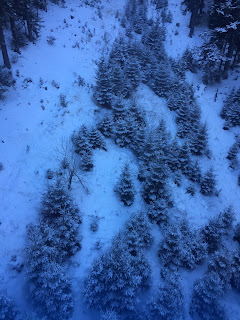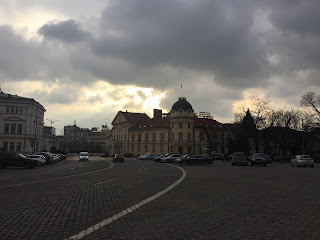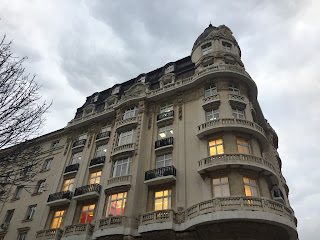A four day trip to Bulgaria
Friday, 6 January 2017
Bansko
Bansko is a ski and mountain resort located in the south-western
part of Bulgaria. The town is situated 6 km from the town of Razlog and
160 km from the capital of Sofia. Bansko lies on the two banks of the
Glazne river at the foot of the Pirin mountain, right bellow the highest
part of it. The Pirin mountain is an Alpine type mountain with its
highest peak. The town of Bansko is located 925m
above the sea level whereas its ski area.
So we waked up after a 3 hours sleep to get ready for breakfast and ski. We went to Gondola Lift Station, which connects Bansko with Banderishka Polyana. Up at Baderishka Polyana you can use ski slopes 1 and 2, there are tubing, restaurants, children’s play area and a soccer field. Our lift pass price was each 20 Lev, 10 Euro. Also we were so glad to be at the traditional Bansko Season Opening 2016/17.
Here are some pictures:
After having an amazing time we went for dinner at the Restaurant Barbeque Stone Flower.
Then we headed to a Karaoke bar and we had the best time ever, we really enjoyed it.
Back to the hotel, for an early morning wake up, a quick breakfast and the way back.
We did a stop to Sandanski, which is a town and a recreation centre in south-western Bulgaria. Named after revolutionary Yane Sandanski, it is situated in a valley at the foot of Pirin Mountains, along the banks of Sandanska Bistritsa River. Sandanski is about 20 km away from Bulgaria-Greece border and 100 km away from Aegean sea.
The town has a convenient location, mild to warm climate and relatively high concentration of thermal water springs, which all make it a very popular destination for relaxation, recreation and shopping.
So we waked up after a 3 hours sleep to get ready for breakfast and ski. We went to Gondola Lift Station, which connects Bansko with Banderishka Polyana. Up at Baderishka Polyana you can use ski slopes 1 and 2, there are tubing, restaurants, children’s play area and a soccer field. Our lift pass price was each 20 Lev, 10 Euro. Also we were so glad to be at the traditional Bansko Season Opening 2016/17.
Here are some pictures:
 |
| Photo Credit Maria Alexopoulou |
After having an amazing time we went for dinner at the Restaurant Barbeque Stone Flower.
Then we headed to a Karaoke bar and we had the best time ever, we really enjoyed it.
Back to the hotel, for an early morning wake up, a quick breakfast and the way back.
We did a stop to Sandanski, which is a town and a recreation centre in south-western Bulgaria. Named after revolutionary Yane Sandanski, it is situated in a valley at the foot of Pirin Mountains, along the banks of Sandanska Bistritsa River. Sandanski is about 20 km away from Bulgaria-Greece border and 100 km away from Aegean sea.
The town has a convenient location, mild to warm climate and relatively high concentration of thermal water springs, which all make it a very popular destination for relaxation, recreation and shopping.
 |
| View from our window on our last day |
 |
| Sandanski |
Second Stop Sofia
After a 2 hour drive from Rilla Monastery, passing through some villages and a big highway, we arrived to Sofia.
Entering into town you can see old residential blocks, some new shopping centers and small shops, to be honest I was a bit disappointed, because it looked nothing like from what I saw, when I google it. Then our guide came and she took us to all the attractions of Sofia by foot. I was blown away. Amazing buildings with beautiful architecture, big parks and everywere you looked so clean. First stop was at the St. Alexander Nevsky Cathedral. The gold-domed Alexander Nevsky Cathedral was built in the early 20th century in memory of the 200,000 Russian, Ukrainian, Belorussian and Bulgarian soldiers, who died in the Russo-Turkish War, 1877–1878. It is one of the largest Eastern Orthodox cathedrals in the world. The cathedral’s gold-plated dome is 45 m high, with the bell tower reaching 50.52 m.
Here are some pictures:
Our next stop was at Church of St. Sophia. The early Byzantine Church of St Sophia was built in the 6th century on the place of an ancient Roman theatre and several earlier churches. During the Second Bulgarian Empire the structure served as the cathedral of the city but was later converted to a mosque by the Ottoman Empire.
Here are some pictures:
Passing through some parks we saw a few historic statues then we arrived to our next stop, which was the St. Nicholas the Miracle-Maker.
This is the church of St Nicholas the Miracle-Maker also known as the Russian church in Sofia. This extraordinary white and green building was designed by Russian architect Preobrajenski and built by Russian workers, some of them worked on the Alexander Nevsky Cathedral, from 1912 until 1914.
Here are some pictures:
Then we headed to the National Ethnographic Museum, which is housed in the premises of the former Royal Palace, a remarkable building in the center of Sofia from the end of the 19th century – a monument of culture. The purpose of the National Ethnographic Museum is to collect, preserve and expose everything connected to the Bulgarian ethno cultural wealth. The Museum possesses more then 50000 collection items.
Here are some pictures on our way to the National Ethnographic Museum:
Our last stop was at the The Presidency building and "St. George" Rotunda.
The President practically governs the country during the period between a dissolution of the National Assembly and the conduct of early parliamentary elections. In this caseth e President appoints a caretaker cabinet, which is accountable to him or her.
The president office is in the Presidency building located at 2 Dondukov Blvd.
Here are some pictures on our way to the The Presidency building:
After our great tour in Sofia, we had free time to do whatever we wanted before we headed back to Bansko. It was really cold and it started snowing. It was really magical. So we went to a German Christmas Market at Stefan Stambolov Square.
Here are some pictures:
Time to go back to Bansko, after we arrived we went for our dinner buffet, then straight to our room to get ready for our second night out.
Entering into town you can see old residential blocks, some new shopping centers and small shops, to be honest I was a bit disappointed, because it looked nothing like from what I saw, when I google it. Then our guide came and she took us to all the attractions of Sofia by foot. I was blown away. Amazing buildings with beautiful architecture, big parks and everywere you looked so clean. First stop was at the St. Alexander Nevsky Cathedral. The gold-domed Alexander Nevsky Cathedral was built in the early 20th century in memory of the 200,000 Russian, Ukrainian, Belorussian and Bulgarian soldiers, who died in the Russo-Turkish War, 1877–1878. It is one of the largest Eastern Orthodox cathedrals in the world. The cathedral’s gold-plated dome is 45 m high, with the bell tower reaching 50.52 m.
Here are some pictures:
Our next stop was at Church of St. Sophia. The early Byzantine Church of St Sophia was built in the 6th century on the place of an ancient Roman theatre and several earlier churches. During the Second Bulgarian Empire the structure served as the cathedral of the city but was later converted to a mosque by the Ottoman Empire.
Here are some pictures:
Passing through some parks we saw a few historic statues then we arrived to our next stop, which was the St. Nicholas the Miracle-Maker.
This is the church of St Nicholas the Miracle-Maker also known as the Russian church in Sofia. This extraordinary white and green building was designed by Russian architect Preobrajenski and built by Russian workers, some of them worked on the Alexander Nevsky Cathedral, from 1912 until 1914.
Here are some pictures:
Then we headed to the National Ethnographic Museum, which is housed in the premises of the former Royal Palace, a remarkable building in the center of Sofia from the end of the 19th century – a monument of culture. The purpose of the National Ethnographic Museum is to collect, preserve and expose everything connected to the Bulgarian ethno cultural wealth. The Museum possesses more then 50000 collection items.
Here are some pictures on our way to the National Ethnographic Museum:
 |
| National Ethnographic Museum |
 |
| National Ethnographic Museum |
 |
| National Ethnographic Museum |
Our last stop was at the The Presidency building and "St. George" Rotunda.
The President practically governs the country during the period between a dissolution of the National Assembly and the conduct of early parliamentary elections. In this caseth e President appoints a caretaker cabinet, which is accountable to him or her.
The president office is in the Presidency building located at 2 Dondukov Blvd.
Here are some pictures on our way to the The Presidency building:
 |
| The Presidency building |
 |
| The Presidency building |
 |
| "St. George" Rotunda |
 |
| "St. George" Rotunda |
After our great tour in Sofia, we had free time to do whatever we wanted before we headed back to Bansko. It was really cold and it started snowing. It was really magical. So we went to a German Christmas Market at Stefan Stambolov Square.
Here are some pictures:
Time to go back to Bansko, after we arrived we went for our dinner buffet, then straight to our room to get ready for our second night out.
Subscribe to:
Comments (Atom)



































































































